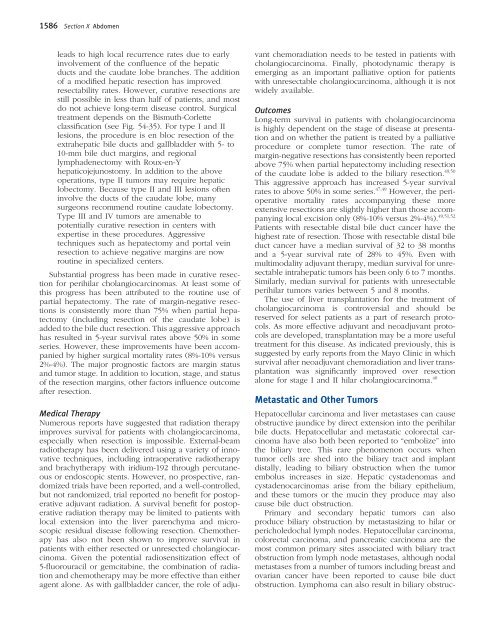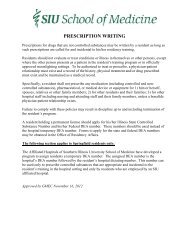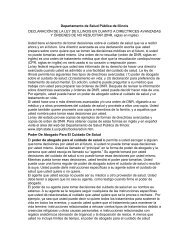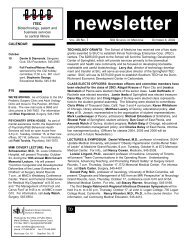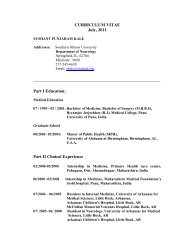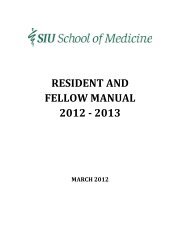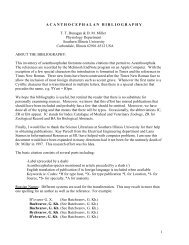Ch. 54 – Biliary System
Ch. 54 – Biliary System
Ch. 54 – Biliary System
You also want an ePaper? Increase the reach of your titles
YUMPU automatically turns print PDFs into web optimized ePapers that Google loves.
1586 Section X Abdomen<br />
leads to high local recurrence rates due to early<br />
involvement of the confl uence of the hepatic<br />
ducts and the caudate lobe branches. The addition<br />
of a modifi ed hepatic resection has improved<br />
resectability rates. However, curative resections are<br />
still possible in less than half of patients, and most<br />
do not achieve long-term disease control. Surgical<br />
treatment depends on the Bismuth-Corlette<br />
classifi cation (see Fig. <strong>54</strong>-35). For type I and II<br />
lesions, the procedure is en bloc resection of the<br />
extrahepatic bile ducts and gallbladder with 5- to<br />
10-mm bile duct margins, and regional<br />
lymphadenectomy with Roux-en-Y<br />
hepaticojejunostomy. In addition to the above<br />
operations, type II tumors may require hepatic<br />
lobectomy. Because type II and III lesions often<br />
involve the ducts of the caudate lobe, many<br />
surgeons recommend routine caudate lobectomy.<br />
Type III and IV tumors are amenable to<br />
potentially curative resection in centers with<br />
expertise in these procedures. Aggressive<br />
techniques such as hepatectomy and portal vein<br />
resection to achieve negative margins are now<br />
routine in specialized centers.<br />
Substantial progress has been made in curative resection<br />
for perihilar cholangiocarcinomas. At least some of<br />
this progress has been attributed to the routine use of<br />
partial hepatectomy. The rate of margin-negative resections<br />
is consistently more than 75% when partial hepatectomy<br />
(including resection of the caudate lobe) is<br />
added to the bile duct resection. This aggressive approach<br />
has resulted in 5-year survival rates above 50% in some<br />
series. However, these improvements have been accompanied<br />
by higher surgical mortality rates (8%-10% versus<br />
2%-4%). The major prognostic factors are margin status<br />
and tumor stage. In addition to location, stage, and status<br />
of the resection margins, other factors infl uence outcome<br />
after resection.<br />
Medical Therapy<br />
Numerous reports have suggested that radiation therapy<br />
improves survival for patients with cholangiocarcinoma,<br />
especially when resection is impossible. External-beam<br />
radiotherapy has been delivered using a variety of innovative<br />
techniques, including intraoperative radiotherapy<br />
and brachytherapy with iridium-192 through percutaneous<br />
or endoscopic stents. However, no prospective, randomized<br />
trials have been reported, and a well-controlled,<br />
but not randomized, trial reported no benefi t for postoperative<br />
adjuvant radiation. A survival benefi t for postoperative<br />
radiation therapy may be limited to patients with<br />
local extension into the liver parenchyma and microscopic<br />
residual disease following resection. <strong>Ch</strong>emotherapy<br />
has also not been shown to improve survival in<br />
patients with either resected or unresected cholangiocarcinoma.<br />
Given the potential radiosensitization effect of<br />
5-fl uorouracil or gemcitabine, the combination of radiation<br />
and chemotherapy may be more effective than either<br />
agent alone. As with gallbladder cancer, the role of adju-<br />
vant chemoradiation needs to be tested in patients with<br />
cholangiocarcinoma. Finally, photodynamic therapy is<br />
emerging as an important palliative option for patients<br />
with unresectable cholangiocarcinoma, although it is not<br />
widely available.<br />
Outcomes<br />
Long-term survival in patients with cholangiocarcinoma<br />
is highly dependent on the stage of disease at presentation<br />
and on whether the patient is treated by a palliative<br />
procedure or complete tumor resection. The rate of<br />
margin-negative resections has consistently been reported<br />
above 75% when partial hepatectomy including resection<br />
of the caudate lobe is added to the biliary resection. 49,50<br />
This aggressive approach has increased 5-year survival<br />
rates to above 50% in some series. 47,49 However, the perioperative<br />
mortality rates accompanying these more<br />
extensive resections are slightly higher than those accompanying<br />
local excision only (8%-10% versus 2%-4%). 49,51,52<br />
Patients with resectable distal bile duct cancer have the<br />
highest rate of resection. Those with resectable distal bile<br />
duct cancer have a median survival of 32 to 38 months<br />
and a 5-year survival rate of 28% to 45%. Even with<br />
multimodality adjuvant therapy, median survival for unresectable<br />
intrahepatic tumors has been only 6 to 7 months.<br />
Similarly, median survival for patients with unresectable<br />
perihilar tumors varies between 5 and 8 months.<br />
The use of liver transplantation for the treatment of<br />
cholangiocarcinoma is controversial and should be<br />
reserved for select patients as a part of research protocols.<br />
As more effective adjuvant and neoadjuvant protocols<br />
are developed, transplantation may be a more useful<br />
treatment for this disease. As indicated previously, this is<br />
suggested by early reports from the Mayo Clinic in which<br />
survival after neoadjuvant chemoradiation and liver transplantation<br />
was signifi cantly improved over resection<br />
alone for stage I and II hilar cholangiocarcinoma. 40<br />
Metastatic and Other Tumors<br />
Hepatocellular carcinoma and liver metastases can cause<br />
obstructive jaundice by direct extension into the perihilar<br />
bile ducts. Hepatocellular and metastatic colorectal carcinoma<br />
have also both been reported to “embolize” into<br />
the biliary tree. This rare phenomenon occurs when<br />
tumor cells are shed into the biliary tract and implant<br />
distally, leading to biliary obstruction when the tumor<br />
embolus increases in size. Hepatic cystadenomas and<br />
cystadenocarcinomas arise from the biliary epithelium,<br />
and these tumors or the mucin they produce may also<br />
cause bile duct obstruction.<br />
Primary and secondary hepatic tumors can also<br />
produce biliary obstruction by metastasizing to hilar or<br />
pericholedochal lymph nodes. Hepatocellular carcinoma,<br />
colorectal carcinoma, and pancreatic carcinoma are the<br />
most common primary sites associated with biliary tract<br />
obstruction from lymph node metastases, although nodal<br />
metastases from a number of tumors including breast and<br />
ovarian cancer have been reported to cause bile duct<br />
obstruction. Lymphoma can also result in biliary obstruc-


